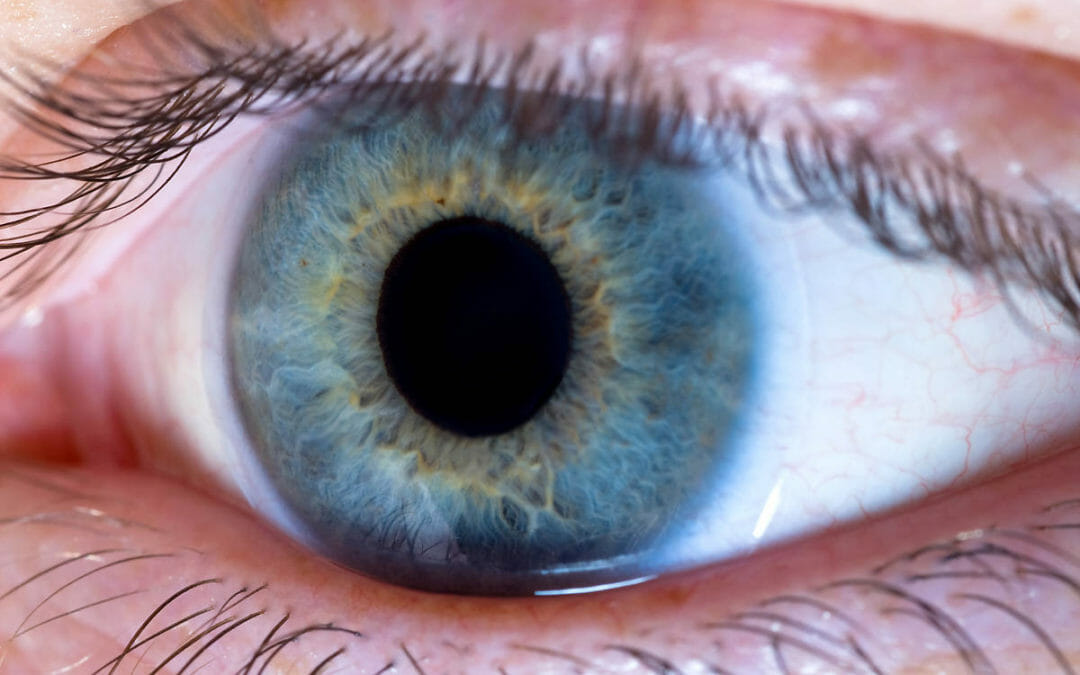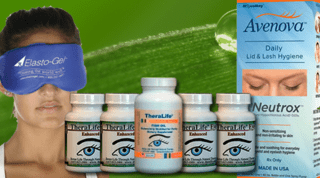Blepharitis home treatment
Learn how to manage on your own through proven blepharitis home treatment from TheraLife.
Blepharitis is an extremely common eye condition.
For most purposes, blepharitis means a chronic form of eyelid inflammation.
Blepharitis is an inflammatory condition affecting the area around the base of the eyelashes.
The underlying causes of chronic blepharitis are not well understood.
Blepharitis is not caused by just poor hygiene.
The most obvious signs of blepharitis are redness and stickiness of the eyelid, with clumping of scaly skin around the base of the eyelashes resulting in crusty eyelids.
Symptoms can be caused by several reasons including inflammation of eyelids or crusty eyelashes.
Several researchers say that blepharitis has been considered the least well known eye disease worldwide and has been underdiagnosed.
Blepharitis has been linked in many ways to serious eye disease if not treated early on.
A glance: Blepharitis
Symptoms: Itching and burning eyes.
Tell me the best way to check for blepharitis?
You may want to consult an eye doctor before taking any drugs to prevent blepharitis. Throughout this examination, your doctor will look closely at your eye lids and brows.
It may also be using a light or a magnifying device.
Symptoms of blepharitis
Those most commonly reported signs and symptoms of blepharitis include (3).
- Intense burning sensation under their eyes.
- Irritation.
- Swollen eyelids
- Serious complications including eye loss and damage to other eye cells such as the cornea and slits.
- Infection may occur when the affected area is touched.
Meibomian gland dysfunction
Meibomian blepharitis patients have a blockage of the oil glands in the eyelids, poor quality of tears and redness of the lining of the eyelids.
However it is important to consult your eye doctor regularly.
Tell me the type of blepharitis?
Blepharitis is one type. It is possible to have just one blepharitis, and you have two different kinds of this.
Anterior blepharitis.
Anterior blepharitis affects your eyelids.
This is normally caused when bacteria are found under the skin and then they can develop.
Allergy or mites can also cause anterior blepharitis, although it is uncommon.
Anterior blepharitis is usually due to bacterial infections (staphylococca blepharitis) or scalp dandruff causing a dry appearance.
This infection can occur on the face and the lids, although it is common for them to be on the face.
Often the anterior blepharitis of the eyelids is caused by staph bacteria or dandreous scalps or eyebrows – the term is “seborrheic blepharitis”.
Posterior blepharitis.
Posterior blepharitis affects the inside edges — which are the parts where the eye is touched.
Posterior blepharitis can occur when the glands of the eyelids irregularly produce oil (meibomian blepharitis).
This creates a favorable environment for bacterial growth.
Posterior blepharitis occurs in patients with blepharitis caused by abnormal gland production. It creates favorable conditions for bacteria to thrive.
Posterior blepharitis can also develop as a result of other skin conditions, such as rosacea and scalp dandruff.
Causes of blepharitis?
Typically eye disorders result in swelling of the eyelids that causes inflammation.
Blepharitis occurs when your eyelids become inflamed from clogged oil glands (Meiboamin Gland Dysfunction- MGD).
The part of the eyelid that usually becomes inflamed is near where the eyelashes grow.
This inflammation affects both eyelids.
Besides inflamed eyelids, your eyes can get irritated and become red.
The pain is often irritating and itchy.
And some people with blepharitis have more severe symptoms such as blurred vision or inflammation of the skin.
Bacterial infection
All skin has bacteria.
Some people have found bacteria to thrive under their eyelids.
Symptoms are irritations and inflammations and can be indicative of staphylococcal blepharitis.
A lack of clean skin causes anterior blepharitis and is easily treated with a sanitary product and antibiotic.
Demodex Mites
Generally allergies and mite infestation of eyesight causes anterior blepharitis.
Skin conditions
Blepharitis can be caused by: a type of bacteria that lives on the skin a skin condition, such as seborrhoeic dermatitis and the glands inside the eyelids not producing enough oil (MGD)
Meibomain Gland Dysfunction
Risk factors
Poor Sanitation
The bacteria that cause anterior blepharitis can be caused by poor sanitation.
If the eyelids or the face are overreacted to contaminated bacteria, the infection could develop.
This allows for bacterial life and growth in folds and crevices on eyelids.
This bacterial infection causes redness, burn and irritation of the eyelid.
Skin Conditions
Posterior Blepharitis may be caused by various skin problems, including rosacea or scalp dandruff.
Diagnosis
Blepharitis has been identified using eye examination.
A blepharitis diagnosis is determined based upon the appearance of eye lid margins.
Treating blepharitis
Depending on the severity of underlying conditions your doctor can give you a list of recommended treatments, these include medicines for infection treatment.
Blepharitis treatments depend upon a patient.
Blepharitis treatment aims in general to prevent irritated areas in the eye and reduce vascular inflammation.
Dandruff shampoo – to clear dandruff and flaky skin that causes blepharitis.
Eye drops
Eye drops or lube ointment are sometimes given to treat irritations to the eye.
Medications that fight infection.
Antibiotics
Using an anti-biotic on an eyelid can relieve symptoms and reduce bacterial infections.
Antibiotics applied to the eyelid have been shown to provide relief of symptoms and resolve bacterial infection of the eyelids.
These are available in several forms, including eye drops, creams and ointments.
These items have various forms and include eye drops lotions and ointments. In some instances your doctor can prescribe a topical antibiotic.
Anti-inflammatories
Topical and systematic anti-inflammatory treatment is usually prescribed for treatment of ocular rosacea sarcoma.
Steroids
Corticosteroid treatment may also reduce symptoms of blepharitis, especially in conjunction with topical antibiotic therapy.
Although the combination can provide quick relief from symptoms, prolonged usage can result in harmful side effects.
Intense Pulsed Light
Some treatments, such as intense pulsed light, could remove clogged glands.
Omega 3 fish oil
A diet rich in omega3 fatty acids can aid with blepharitis related to especially as it relates to Rosacea.
Omega 3 is strongly anti-inflammatory.
Omega-3 fats exist in fish products as well as salmon, tuna, flax seed oil and nuts.
Blepharitis home treatment
Sanitation
The best bleparitis home treatment is to keep your eyelids clean and free of crusts.
During flare ups, you should follow these steps two to four times a day for blepharitis treatment until things have calmed down.
- First, you should use a warm compress (gel or microbeads) and place it over your closed eyes for at least 10 minutes. Gently rub your eyelids to loosen any deposits on your eyelids and melt the clogging in your oil glands. This is the most effective blepharitis home treatment.
- Second, clean eyelids using an eyelid cleanser and a cotton make up remover. We highly recommend Avenova – it is gentle enough to wash away any debris or flakes at the bottom of your eyelashes and prevent bacterial re-attachments. Great blepharitis home treatment to follow.
- Demodex – Using tea tree oil shampoo on your eyelids daily might help deal with mites. Tea tree oil can be harsh. If this is too much, try scrubbing 50% tea tree oil on your eyelids once a week. Important to follow if you are trying to do blepharitis home treatment if you have irritated red eyelids. Could be from using tea tree oil if you don’t have mites.
Blepharitis home treatment measures, such as washing your eyes and using warm compresses, might be all that’s needed for most cases of blepharitis.
This includes frequently washing the scalp and face, using warm compresses to soak the eyelids and scrubbing the eyelids.
Do not wear contact lenses while you have symptoms do not use eye makeup, especially eyeliner and mascara, while you have symptoms.
Make up
Limit or stop using eye makeup during blepharitis home treatment, as it makes lid hygiene more difficult.
Do not use eye makeup, especially eyeliner and mascara, while you have symptoms.
How to clean your eyes.
Soak a clean flannel or cotton wool in warm water and place it on your closed eyelid for 5 to 10 minutes. Gently massage your eyelids for around 30 seconds. Clean your eyelids using cotton wool or a cotton bud. It might help to use a small amount of baby shampoo in warm water. Note we do not advise using baby shampoo – because it does not resolve blepharitis symptoms.
Contact lenses
Don’t do not wear contact lenses while you have symptoms.
Best All Natural Blepharitis Home Treatment- TheraLife
Tell me the best way to prevent blepharitis?
In the event that your eyelid is inflamed and irritation occurs it is necessary to keep it clean.
By touching and rubbing the irritated area, a secondary infection can also result.
Preparing for your appointment
You may first see the doctor. Usually, eyelid conditions can cause problems if the eyelid is too small or it is too big. Tell us a bit about your appointment.
Do clean your eyelids twice a day to start with and then once a day as your symptoms improve continue to clean your eyes, even if your symptoms clear up.
Do not wear contact lenses while you have symptoms
Stop wearing eye makeup, especially eyeliner and mascara, while you have symptoms
From Mayo Clinic to your inbox
Subscribe to our free newsletter and learn about new health topics, such as COVID19 and other topics. To help you understand and find useful information, we use email and Web Site Usage data to gather information we know from others. This information may be included by a Mayo Clinic physician in order to protect your medical records. When a health-related incident occurs with your protected health information, we will treat that information as protected health data.
References
National Eye Institute. https://www.nei.nih.gov/learn-about-eye-health/eye-conditions-and-diseases/blepharitis. Accessed Jan. 25, 2020.





